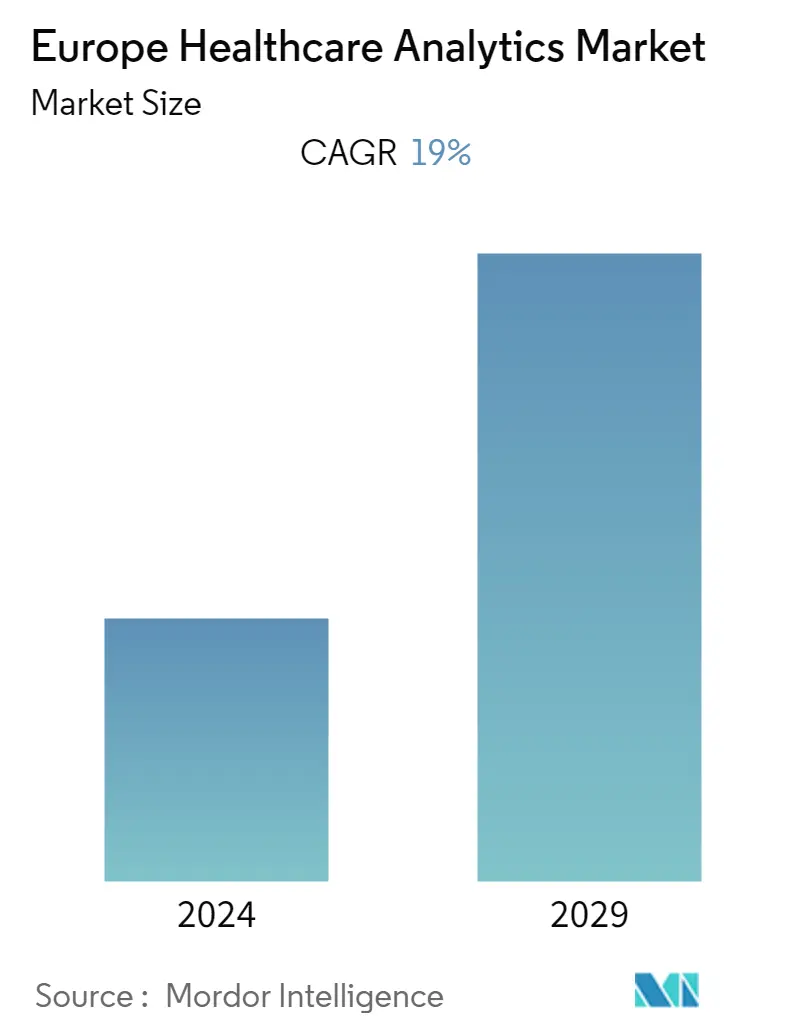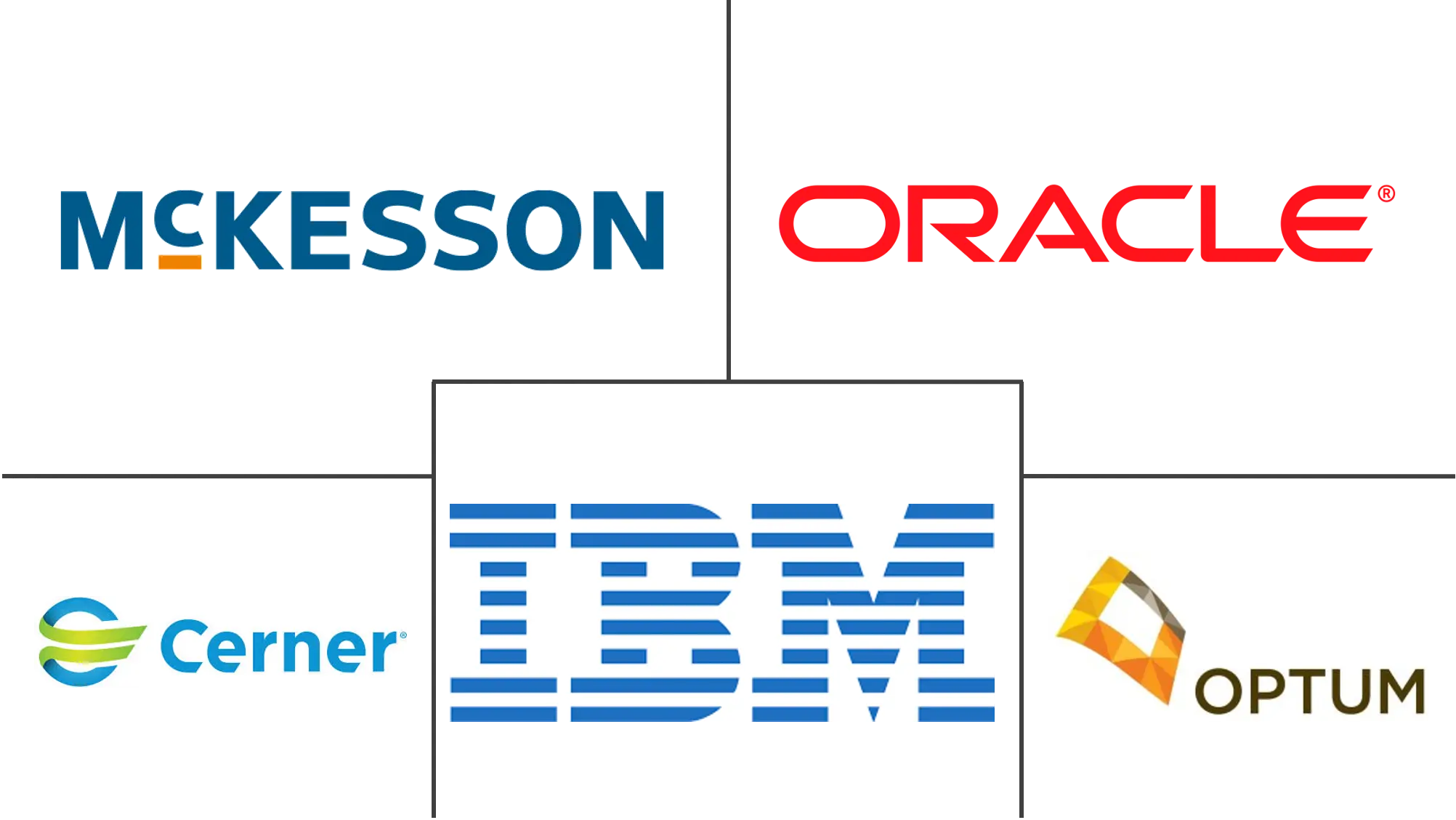Market Size of Europe Healthcare Analytics Industry

| Study Period | 2021 - 2029 |
| Base Year For Estimation | 2023 |
| Forecast Data Period | 2024 - 2029 |
| Historical Data Period | 2021 - 2022 |
| CAGR | 19.00 % |
| Market Concentration | High |
Major Players
*Disclaimer: Major Players sorted in no particular order |
Europe Healthcare Analytics Market Analysis
The European Healthcare Analytics market is projected to register a CAGR of 19% over the forecast period. Advanced analytics are being used more and more in healthcare so that data-driven insights can be gained faster. This is one of the main things driving the market.
- COVID-19 had a slightly positive impact on the healthcare analytics market, which has been largely attributed to the current focus of pharmaceutical and biotech companies on developing a therapeutic drug or vaccine for COVID-19. Some companies are also conducting clinical trials for their specific drug components. Analytics, which is important in clinical trials and dealing with large databases, has been discovered to be useful in the current situation of the COVID-19 global outbreak.
- With the increasing number of data records in the healthcare sector, the adoption of advanced analytics is increasing to provide data-driven insights faster, which is one of the primary factors driving the market. The market is driven by lower costs for health care and the expectation that emergency services will be needed. Patient patterns and histories can be identified more efficiently with digitized healthcare records. Predictive analytics can isolate patients who may be at high risk of crises due to chronic health problems, allowing physicians to provide corrective plans that decrease emergency visits, thus further reducing the overall cost of resources. With the advent of digital devices such as IoT and applications that are increasingly becoming part of the healthcare system in Europe, various government initiatives to support and incentivize the use of technological solutions in healthcare further boost the demand for data analytics.
- Apart from this, connected devices that generate huge amounts of data are expected to increase significantly; this raw data can be analyzed to make better enterprise decisions. According to European Telecommunications Network Operators (ETNO), the number of IoT active connections in healthcare in the EU during 2019 stood at 2.79 million and is expected to reach 10.34 million by 2025. This growth makes the need for data analytics and tools to learn about an industry based on data even stronger.
- Moreover, a surge in the adoption of e-health services in the European Union in recent years is also expected to boost the growth of the studied market. For instance, in September this year, the first-ever digital health action plan for the region was adopted by health ministers and representatives from WHO's 53 European member states. The ambitious agenda will use the digital transformation in Europe and Central Asia to improve the health and well-being of the people.
Further, with the outbreak of various strains of COVID-19, hospitals and healthcare enterprises are increasingly focused on adopting analytics as part of their operations. Patients and doctors rapidly adopted telemedicine and other digital tools to deliver care. According to Tech Nation's Data Commons, the United Kingdom had more than 100 health tech startups with the potential to become USD 1 billion businesses. The UK government announced a fund of USD 1.5 billion, including a USD 600 million investment fund for high-growth companies.
Europe Healthcare Analytics Industry Segmentation
The Europe Healthcare Analytics Market is segmented by Technology Type (Predictive Analytics, Prescriptive Analytics, Descriptive Analytics), Application (Clinical Data Analytics, Financial Data Analytics, and Operational/Administrative Data Analytics), Product(Hardware, Software, and Service), by Mode of Delivery( On-premise Model, Cloud-based Model), by End User(Healthcare Provider, Pharmaceutical Industry, Biotechnology Industry, Academic Organization) and Country (Germany, United Kingdom, France, Italy, Spain, Rest of Europe). The report offers the value (in USD million) for the above segments.
The market sizes and forecasts are provided in terms of value (USD million) for all the above segments.
| By Technology Type | |
| Predictive Analytics | |
| Prescriptive Analytics | |
| Descriptive Analytics |
| By Application | |
| Clinical Data Analytics | |
| Financial Data Analytics | |
| Operational/Administrative Data Analytics |
| By Product | |
| Hardware | |
| Software | |
| Service |
| By Mode of Delivery | |
| On-premise Model | |
| Cloud-based Model |
| By End User | |
| Healthcare Provider | |
| Pharmaceutical Industry | |
| Biotechnology Industry | |
| Academic Organization |
| By Country | |
| Germany | |
| United Kingdom | |
| France | |
| Italy | |
| Spain | |
| Rest of Europe |
Europe Healthcare Analytics Market Size Summary
The European healthcare analytics market is experiencing significant growth, driven by the increasing adoption of advanced analytics to derive data-driven insights swiftly. This trend is fueled by the rising volume of data records in the healthcare sector, which necessitates the use of sophisticated analytics tools. The market's expansion is further supported by government initiatives promoting technological solutions in healthcare, as well as the proliferation of digital devices and IoT applications. The COVID-19 pandemic has also positively impacted the market, as healthcare organizations and pharmaceutical companies have leveraged analytics for clinical trials and vaccine development. The shift towards e-health services and digital health action plans in the European Union is expected to further bolster market growth.
The market is characterized by the presence of major players such as IBM Corporation, Oracle Corporation, McKesson Europe AG, Cerner Corporation, and Optum, Inc., who are focusing on expanding their global footprint through strategic collaborations. These companies are increasingly utilizing real-world data to support regulatory and scientific decision-making, enhancing their market share. Predictive analytics is playing a crucial role in identifying high-risk patients and enabling preventive care, thereby reducing healthcare costs. The European Health Data Space initiative aims to improve healthcare delivery across Europe by facilitating the management and use of health information, promoting a digital health market, and ensuring compliance with data protection regulations.
Europe Healthcare Analytics Market Size - Table of Contents
-
1. MARKET INSIGHTS
-
1.1 Market Overview
-
1.2 Industry Attractiveness - Porter's Five Forces Analysis
-
1.2.1 Bargaining Power of Suppliers
-
1.2.2 Bargaining Power of Buyers
-
1.2.3 Threat of New Entrants
-
1.2.4 Threat of Substitute
-
1.2.5 Intensity of Competitive Rivalry
-
-
-
2. MARKET SEGMENTATION
-
2.1 By Technology Type
-
2.1.1 Predictive Analytics
-
2.1.2 Prescriptive Analytics
-
2.1.3 Descriptive Analytics
-
-
2.2 By Application
-
2.2.1 Clinical Data Analytics
-
2.2.2 Financial Data Analytics
-
2.2.3 Operational/Administrative Data Analytics
-
-
2.3 By Product
-
2.3.1 Hardware
-
2.3.2 Software
-
2.3.3 Service
-
-
2.4 By Mode of Delivery
-
2.4.1 On-premise Model
-
2.4.2 Cloud-based Model
-
-
2.5 By End User
-
2.5.1 Healthcare Provider
-
2.5.2 Pharmaceutical Industry
-
2.5.3 Biotechnology Industry
-
2.5.4 Academic Organization
-
-
2.6 By Country
-
2.6.1 Germany
-
2.6.2 United Kingdom
-
2.6.3 France
-
2.6.4 Italy
-
2.6.5 Spain
-
2.6.6 Rest of Europe
-
-
Europe Healthcare Analytics Market Size FAQs
What is the current Europe Healthcare Analytics Market size?
The Europe Healthcare Analytics Market is projected to register a CAGR of 19% during the forecast period (2024-2029)
Who are the key players in Europe Healthcare Analytics Market?
IBM Corporation, Oracle Corporation, Cerner Corporation, McKesson Europe AG and Optum, Inc. are the major companies operating in the Europe Healthcare Analytics Market.

